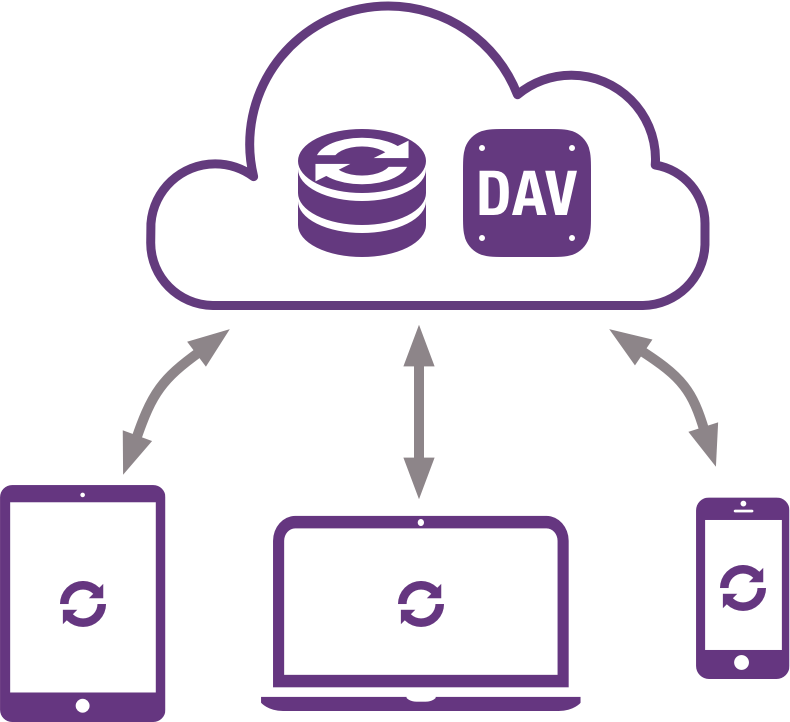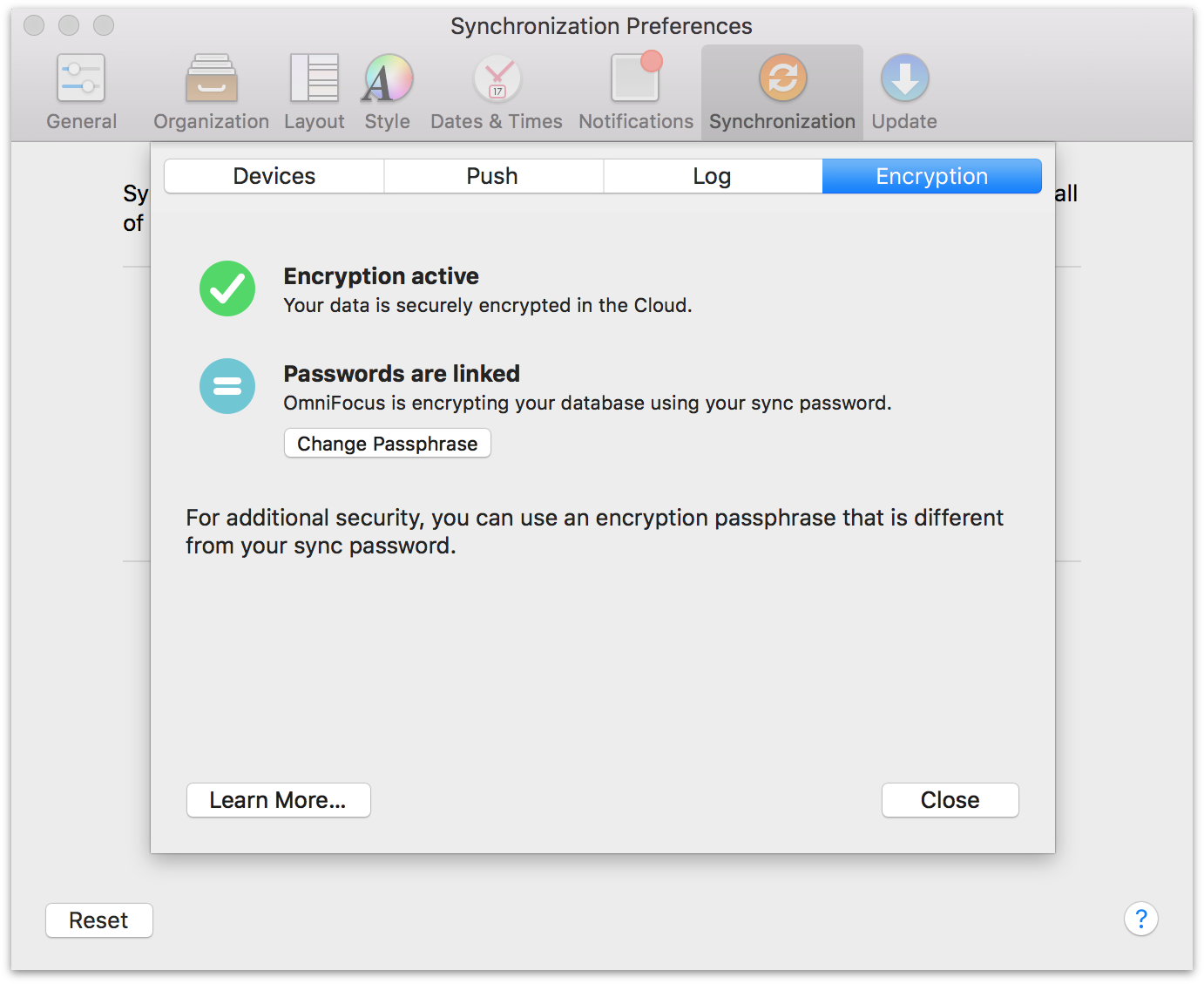Getting Synced
When you first launch OmniFocus 2 you’ll be asked to set up your sync settings. Syncing is important in OmniFocus as an additional layer of backup storage for your data, and enables several of the advanced features of the app such as Mail Drop. If you have OmniFocus for iPhone or iPad, syncing connects you to the latest changes made on any device.

If you’re planning to sync, it’s recommended to do so as part of the app setup process to ensure as smooth a transition as possible between versions, and to provide that added layer of backup right away. If you choose to set up sync later, the same preferences you saw at first launch are available in OmniFocus ▸ Preferences ▸ Synchronization.
Omni Sync Server
The most straightforward sync option available is our very own Omni Sync Server. It’s free, reliable, and supported by Omni’s ace support team; we take care of managing the servers so your data is always available when you need it most.
Get started by creating a new Omni Sync account here:
https://manage.sync.omnigroup.com
Other WebDAV Options
Omni Sync Server is a great syncing solution for most OmniFocus users. If your sync needs require that your data be kept completely within a system you control, you can configure a private WebDAV server to sync your OmniFocus data. This can be a third party server (there are many fine providers out there) or one that lives on your own Mac.
While we’re not able to provide comprehensive support for WebDAV servers we don’t administrate (since it isn’t our software), we’re glad to help you get started with some pointers.
See this support article for a tutorial on setting up your own OmniFocus sync server using Server.app (included with Mac OS X Server).
Another option for self-hosting your own sync server is WebDAVNav Server, a free server application (see the corresponding support article). Please recall that we can't provide troubleshooting assistance for third party apps or services, so once again we recommend Omni Sync Server unless you're running OmniFocus in extraordinary circumstances.
Warning
When you expose files and folders on your computer to the internet (even with password protection), you assume some risk. Make sure you understand this risk before setting up a server, and be sure to keep your Mac up to date with the latest security patches. If you’d prefer not to host your own server, you can sign up for an Omni Sync Server account or use another standards-compliant WebDAV host to sync OmniFocus.
Also note that while services such as Dropbox are great for file sharing, they can’t handle OmniFocus data properly for syncing purposes. Using Dropbox as a place to store your OmniFocus data can corrupt it. Do not use Dropbox as a means of synchronizing your OmniFocus data.
How Synchronization Works
With sync turned on in OmniFocus, a server you designate keeps a copy of your database so that it’s always available wherever you are. With each subsequent sync, OmniFocus compares your local database with what’s on the server and applies any differences to the database on the server (or vice versa, bringing the latest changes from the server to your device).
We’ve also built in an automatic sync mechanism. With sync turned on, OmniFocus sends new changes to the sync server after one minute, or when opening or closing the app. At a bare minimum, OmniFocus checks in with the server every hour if nothing has changed on the device. This helps ensure that your data from OmniFocus is always safe, secure, and most importantly—up to date.
Tip
Devices with OmniFocus 2 (on any platform) that sync to the same server account and are connected to the same Wi-Fi network will prompt each other to sync when any new changes are pushed to the server. Nifty!
If you’ve made changes you want to view immediately on other devices, you’ll want to perform a manual sync (by clicking the Sync button in OmniFocus) before switching to OmniFocus on another device. This pushes your latest changes up to the sync server, so that when you launch OmniFocus on the other system, all you have to do is click or tap Sync to ensure that all of your changes are there.
Note
In OmniFocus 2.4, synchronization is even more robust with the addition of push notification-triggered sync. This feature notifies your other devices with OmniFocus to update whenever you make a change, so manual syncing should rarely — if ever — be required. See this support article for more information on just how it works.
For options related to push-triggered sync, choose Show Sync Details... in the Synchronization Preferences pane of OmniFocus Preferences.
Encryption
OmniFocus sync has always used HTTPS to encrypt your data while in transfer to sync servers that support it (including Omni Sync Server). New with the release of OmniFocus 2.6 for Mac and 2.15 for iOS, all OmniFocus databases set up to sync with remote servers are also automatically encrypted prior to transit, and live encrypted on the server.
Note
Versions of OmniFocus with the database encryption feature also include an updated database format that requires migration from previous versions for compatibility between all your devices with OmniFocus.
After updating one device to a version that supports encryption, you'll see guidance on which other devices must be updated before the migration can take place.
For details on the migration process see Migrating Your Database.
Encryption is done by OmniFocus on your Mac or iOS device at the time the database is transmitted to the sync server. This means that regardless of the sync destination (Omni Sync Server or another WebDAV server), encryption-based security is preserved. OmniFocus doesn't actively encrypt data while in storage on your local device, instead deferring to any system-level encryption you have in place.
Technical details of the encryption scheme for OmniFocus can be found in this forum post.
Warning
After migrating to the new database format, if you're set up to publish due items as calendar alarms, a portion of your data will remain unencrypted while stored as part of the .ics file on the sync server.
Setting a Separate Database Passphrase
By default, OmniFocus uses the password you chose when setting up your sync account to encrypt your database on the server. For an extra layer of security, you can use a distinct encryption passphrase by choosing Change Passphrase from the Encryption tab of Show Sync Details in Synchronization Preferences.

This section of Sync Details indicates whether your database is encrypted with your sync password, or a separate one. When you click Change Passphrase, you are prompted to enter your current passphrase (this is the same as your sync password). You can then set and confirm a new passphrase used to encrypt your database on the server.

After setting a new encryption passphrase the Encryption settings indicate that your sync and encryption passwords are distinct. You can unify them again by clicking Link Passwords, or change the encryption passphrase to something new with Change Passphrase.
Note
If you're syncing with OmniFocus on other Macs or iOS devices, after changing your encryption passphrase you will be prompted to enter the new passphrase on each of those devices before you can receive updates from the server.
